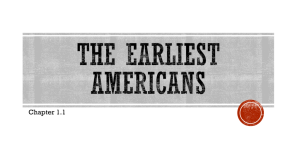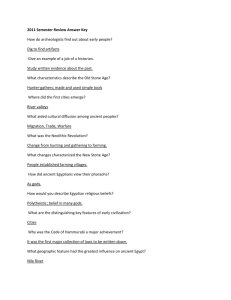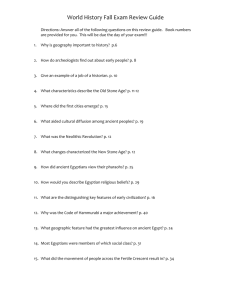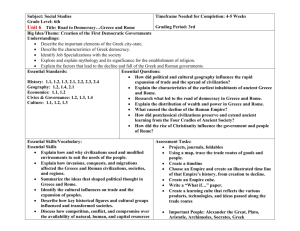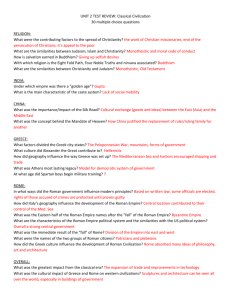Intro to World History
advertisement
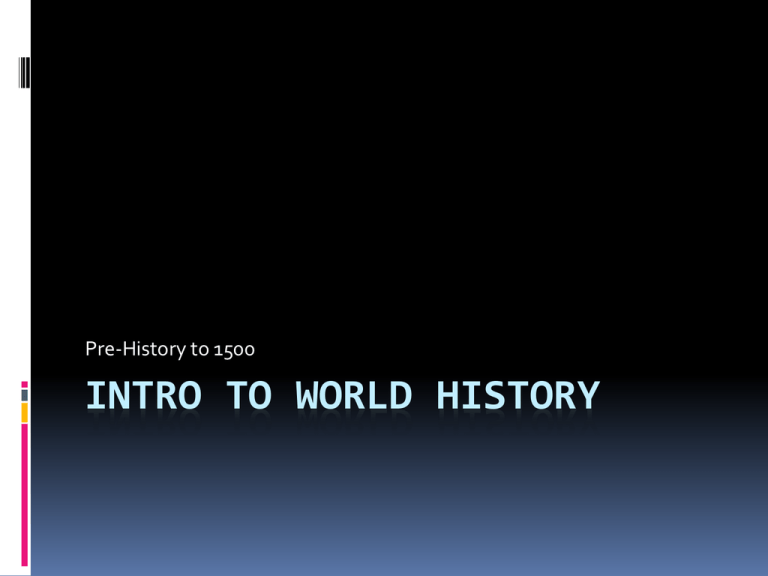
Pre-History to 1500 INTRO TO WORLD HISTORY Introduction History is necessary to human survival Must know where we came from Regardless of beliefs, history begins 2 million BC Dawn of History Old Stone Age or Paleolithic Age “Lucy” 1959 by Leakey's in Tanzania First people were hunters and gatherers Animism – spirits in everything Neolithic Agricultural Revolution – farming and domestication of animals Lead to cities and civilizations Civilizations grew along rivers Features of Civilization Organized Government Complex Religions Job Specialization Social Classes Arts and Architecture Public Works Writing 4 Oldest River Valley Civilizations Ancient Egypt Mesopotamia (Sumer and Babylon) Ancient China Ancient India Egypt Along the Nile River with yearly floods Pharaohs seen as gods, ruled in dynasties Religion – polytheism, gods for nature Afterlife – Osiris, mummification, tombs Pyramids used as tombs Hieroglyphics written on papyrus Sumer and Babylon Fertile crescent – Tigris and Euphrates City-states ruled by hierarchy Built ziggurats for religion Cuneiform – wedge writing Sargon – 1st empire builder Hammurabi – code, 1st written laws Phoenicians create the alphabet China Grew around Huang He (Yellow) River Dynasties – Shang, Zhou Religion – polytheism, ancestor worship Mandate of Heaven – divine right to rule Feudal state Silk making, first books India Grew around Indus River Valley Polytheistic with mother goddess Aryan society: Brahmins, Kshatriyas, Vaisyas Vedas – story of early Indian civilizations Greece – Early People Minoan Civilization Island of Crete in Aegean Sea King Minos and Palace at Knossos Disappeared, volcano and tidal wave Mycenae Sea traders, moved ideas and items 1250 B.C. Trojan War Fall of Troy same time as Mycenaean disappearance Greece – Rise of City-States Mountainous peninsula Polis – city Acropolis – high city, temples to gods Monarchy – King or queen rule Aristocracy – rule by landowning elite Oligarchy – Small, powerful, business elite rule Military Iron weapons Phalanx – formation of armed foot soldiers Greece - Sparta Government 2 kings and council of elders, assembly of citizens From birth, trained for military 7 – boys sent to barracks, training, beaten 20 – marry, 30 – move out & join assembly Women – trained, ran estates & business Isolated from trade, looked down on wealth Greece Athens Aristocracy became democracy Democracy – Government by the people Set up legislature – lawmaking body Cared more about art, philosophy than war Good navy Women – secluded in homes, family and kids Education was important above all else Greeks believed all others were barbarians Greece - Religion Polytheistic Many gods and goddesses Zeus – leader, God of Gods and Humans Many children became other gods Used to explain nature Temples built, prayers & ceremonies to placate them Greece and Its Glory Philosophers – Socrates, Plato, Aristotle Developed rhetoric and logic Architecture – columns Sculpture of gods, goddesses, athletes, politicians Drama – Tragedy and Comedy Writers – Homer’s Iliad and Odyssey Alexander the Great King Philip killed at daughter’s wedding Conquered lands: Greece to India, Germany to Egypt Spread cultures, mixed together = Hellenistic Named over 20 cities after himself Conquering more than ruling Traveled 10,000 miles, men made him turn around Died 3 days after return Rome – The Beginning Republic – government of the people Patricians – Upper class, landholding, made laws Consuls – 2 patricians, ran daily government Dictator – Time of war, complete control Plebeians – farmers, merchants, bulk of population Tribunes – Plebeian officials Veto – can block laws harmful to plebeians Roman Society Women given more power, held jobs, business Boys and girls taught to read and write Religions – similar to Greek but different names Citizen-Soldiers were part of legion (5000) Provided own weapons with no pay Conquered lands treated with justice Built roads, connected empire People assimilated and united under Roman rule Rome – Empire Building Imperialism – Establishing control over foreign lands Corruption common, caused declines Reformers - Julius Caesar Popular Military General Public works jobs, reorganized government of providences Created calendar – Julian Calendar Killed by best friend, Brutus Census – count people Good and Bad emperors Pax Romana – Roman Peace Bread and Circuses Roman Achievement Literature – Aeneid, Satirize – make fun of History – Livy, kept track of events Philosophy – Emperor Marcus Aurelius – stoic Art – Sculpture, Mosaic – picture made of tiles Architecture – Huge temples, arch and columns Engineering – built aqueducts Law – Civil Law and Law of Nations Christianity Early Religions tolerated by Romans Most were polytheistic, like Romans Jews rejected Roman religion, persecuted, revolt, fled Jesus born in 4 B.C. Apostles and him spread message of peace, love Deeply rooted in Judaism Romans crucified him for rebellion Seen as religion for all – everyone welcome Roman Decline 26 emperors in 50 years Several tried to help with reforms Invasion by several groups of nomads hurt Rome Causes Military – Mercenaries used, little loyalty Political – Corruption, divided empire Economic – Taxes, slaves ran away, economic downfall Social – Lack of patriotism and devotion Long, slow decline Lead to Byzantine Empire (Western Rome) The Americas - Maya Olmecs – oldest civilization, not on a river Mayas Yucatan peninsula Tikal – huge temples and city Each city had ruling chief Priests had highest power Most people were farmers – corn, cotton, squash Writing system, accurate time, 365 day calendar, zero 900 A.D. began to abandon cities, don’t know why Aztec Civilization Late 1200s – Eagle on cactus with snake in beak Tenochtitlan – city in middle of lake Chinampas – floating gardens Conquered other tribes and demanded tribute Single ruler – royalty, blood letting Nobles, warriors, commoners Massive human sacrifice, used conquered people Calendar, surgery, schools Hernan Cortes destroyed in 1519 Early People of Peru Chavin Worshipped jaguar/man Lived high in the Andes Mochica Built roads, irrigation systems Beautiful pottery Nazca Glyphs – etched lines in the ground Lines, shapes – part of calendar? The Inca Pachacuti – founder and first Sapa Inca 1438 In Cuzco, Sapa lived like god, Queen – Coya Quipu – knotted string collection for records 12,000 miles of road, runners for messages Only runners and army could use roads Farmed on terraces Best metal workers Had anesthesia and brain surgery Polytheistic, temples to gods Destroyed by Pizarro in 1533 North American Natives Crossed Bering Land Bridge, moved south Diverse cultures based on environment Arctic, Coastal, Plains, Woodlands, Southwest Iroquois League – 5 nations banded together Hitting peak when Europeans arrived The Middle Ages Europe carved up by Germanic Tribes, Franks Charlemagne united Europe Wanted “Second Rome”, extended Christianity Feudalism – system of rule among lords and vassals Lord gave vassal a fief thru feudal contract Vassal got land and protection, Lord got food Knights – began at 7, protect castles Castles were self-sufficient Peasants poor, hard life, 35 The Medieval Church Church was the center of towns and lives Cannon Law – churches laws Monastery – school, copied manuscripts, hospital Papal Supremacy – Pope had more power than kings Persecuted Jews – Anti-Semitism Medieval Economy Iron plows, horse harnesses – agriculture 3 Field system – corn, wheat, fallow = more food New trade routes – India and China Barter rather than money Guilds – group of same kind of artisans Set prices, recipes, hours Apprentice, Journeyman, Master High Middle Ages Royal families ruled England and France Kings conflicted with church over power Magna Carta – nobles forced King John to sign King is not exempt from laws Parliament established The Crusades “God wills it” 200 years Take back Jerusalem from Muslims Rape, pillage, kill along way – got rich Economic expansion and grew churches power Into the Darkness The Black Death Rats, fleas spread Bubonic Plague Spread thru Europe via trade 25 million people died No workers, blamed Jews & witches, inflation – 100 years Church Upheaval Popes lived rich lives Church accused of corruption Hundred Years’ War England vs. France in 1337 to 1453 Joan of Arc and Longbow Muslim Civilization Prophet Muhammad had vision = Islam Muslim Civilization was very advanced Art, architecture and literature was distinct Mongols Genghiz Khan crossed Persia Burned and looted Converted to Islam Nomadic people Golden Horde attacked Russia in 1236 Ruled Russia for 240 years Fierce conquerors but tolerant rulers Silk Road International trade network Roads built by Chinese emperor Wu Di 4000 miles from China to Middle East Towns along the road provided markets and lodging
